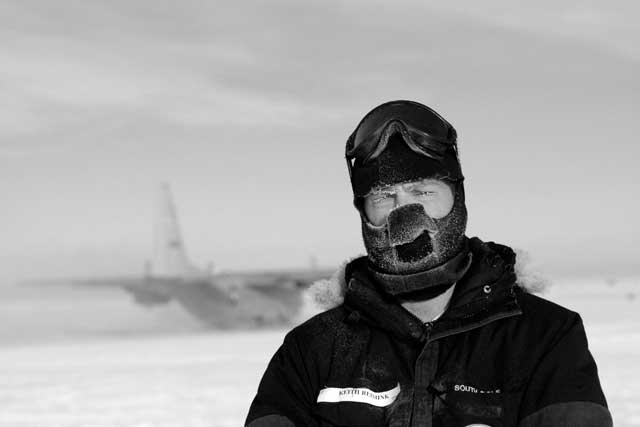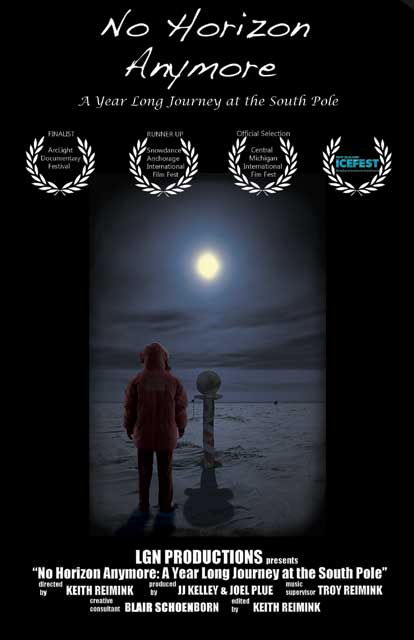|
No Horizon AnymoreDocumentary by former Polie hits film festivals around the countryPosted October 28, 2013
To paraphrase Mark Twain: Accident is the greatest of all inventors. Keith Reimink can certainly relate to that statement. Hired to cook at the Amundsen-Scott South Pole Station Reimink couldn’t find many answers before he embarked on his year-long stint in October 2008, despite already being a veteran of three summer seasons in the kitchen at McMurdo Station “I went into it blind,” says Reimink, 34, by phone from Pittsburgh, where he works as a sous chef for a university. “That was the most hardcore thing you could do in my mind – a winter at South Pole – and I wanted to prepare for it. There was nothing.” Now there’s the documentary, No Horizon Anymore: A Year Long Journey at the Bottom of the World “I tell people it was an accidental documentary,” Reimink says. “I had no plans to make a full-length film out of it. It just came about. I would go to work and then go film something that I thought was cool.” The months went by and two hard drives were eventually filled with interviews, interior shots of the research station, scenes of research experiments, and even rare footage of the auroras that shimmer across the polar night sky light like ghostly green flags fluttering in the wind. It’s the interviews that drive the narrative, particularly the candid moments of his fellow winterovers who describe their boredom and coping strategies in the face of extreme isolation. There are light-hearted moments – tinged with the surreal – watching a couple of men play putt-putt golf down a hallway or being introduced to another person’s anthropomorphized bobblehead collection. “I think Keith did a really great job of showing a more holistic picture of life at Pole – not only the science, but also the ‘grunt’ work and the social life,” says Emily Wampler, one of the winterovers featured in the documentary. “Through his interviews, I think he also captured a glimpse of the different ways people adapt to the environment, and how different personalities react to the various challenges of life in such an isolated place,” she adds. Reimink says he wants viewers to see a layer of Antarctica below the overly polished surface created by BBC wildlife films or the superficial treatment depicted in documentaries like Werner Herzog’s Encounters at the End of the World. “They’re beautiful images captured with expensive equipment,” he says. “I think it’s really important – it is a beautiful place, and it is pristine to a certain extent – but it’s also ugly and it’s demanding. “I missed weddings. I missed funerals. I was an absentee son, brother. You leave part of yourself. It’s not all fun and games,” he adds. “Some of those concepts aren’t expressed in other forms of Antarctic art.” A materialsperson at South Pole Station during the 2009 winter, Wampler says No Horizon Anymore is more authentic because it was shot by someone who was part of the crew. “People weren't acting for Keith; we were just being ourselves – the good, the bad, and the ugly,” she adds. “I’m so grateful Keith was there to document it, because it’s an experience that’s hard to share with others in words. Keith’s film can tell the story much better than I have been able to.” A native of Michigan, Reimink eventually attended New York University “I wanted to get as far away from New York City as I could,” he recalls. Reimink eventually landed a job around Denali National Park “It was two ridiculously different environments in the span of 24 hours,” he says. A co-worker introduced him to an even more radically different environment – Antarctica. Reimink made his first trip to the Ice in 2005-06, and flip-flopped summers between the Northern and Southern hemispheres for the next three years before his year-long stint at South Pole. In November 2009, after completing “the most hardcore thing you could,” Reimink figured he needed a break from the Ice. But an opportunity to go to work at Palmer Station, the smallest and most scenic of the U.S. Antarctic Program’s “You really can’t say no, because it doesn’t come around that often,” he says. Serious editing and production on No Horizon Anymore began during those two winter deployments to Palmer Station Reimink says aside from the film festivals, he is working on plans to get the film distributed on DVD. He recently created his own small film production company, Daliborka Films. In early 2015, he plans to travel to Israel to hike the little-known Israel National Trail for a documentary. “It’s not really a tourist thing, which makes it cool. It’s never really been captured on film, which makes it cooler,” he says. It seems no accident that Reimink will travel halfway across the world for his next film project. Or is it? “Everything came from that first cooking experience in Alaska,” he says. |



For USAP Participants |
For The Public |
For Researchers and EducatorsContact UsU.S. National Science FoundationOffice of Polar Programs Geosciences Directorate 2415 Eisenhower Avenue, Suite W7100 Alexandria, VA 22314 Sign up for the NSF Office of Polar Programs newsletter and events. Feedback Form |






